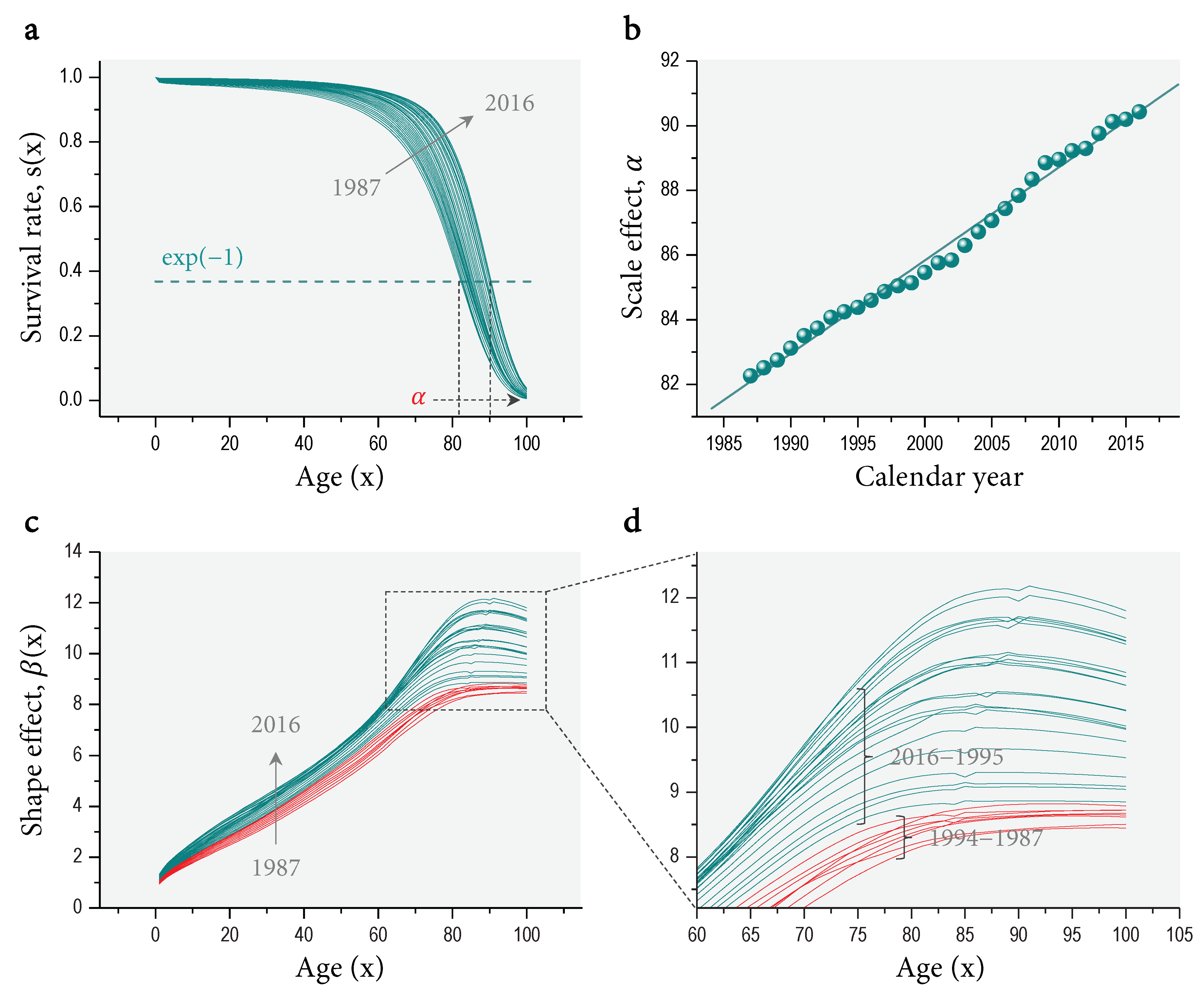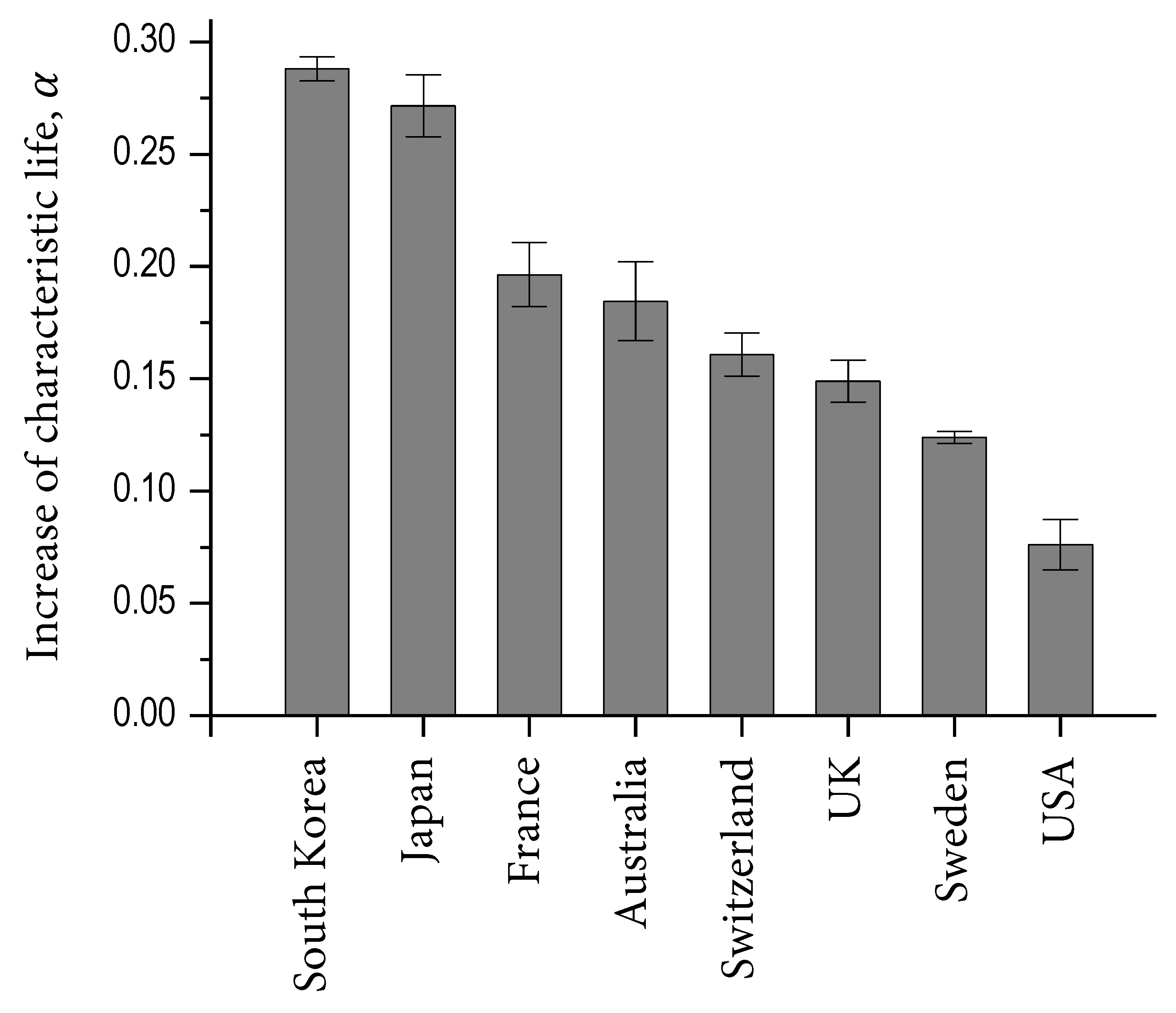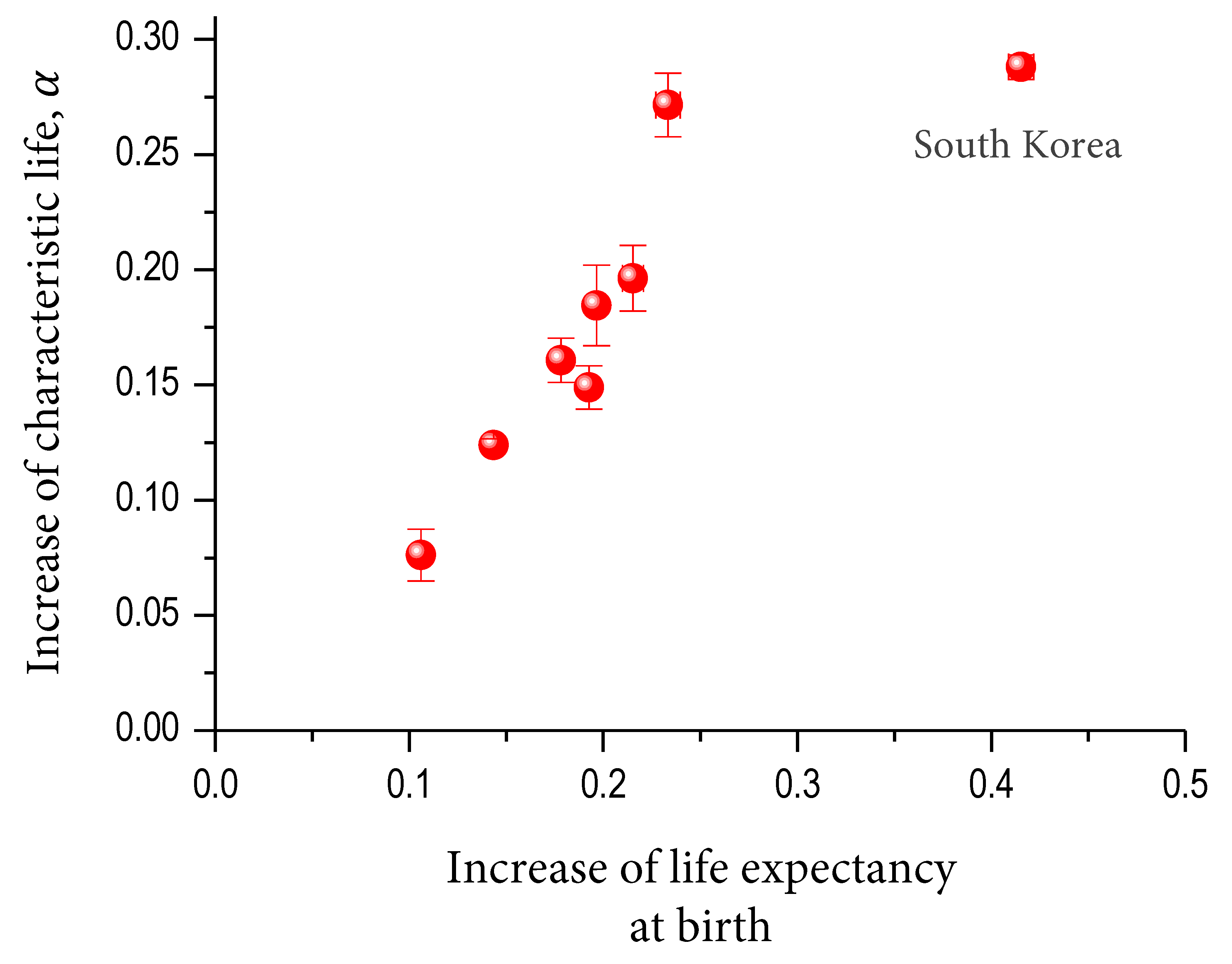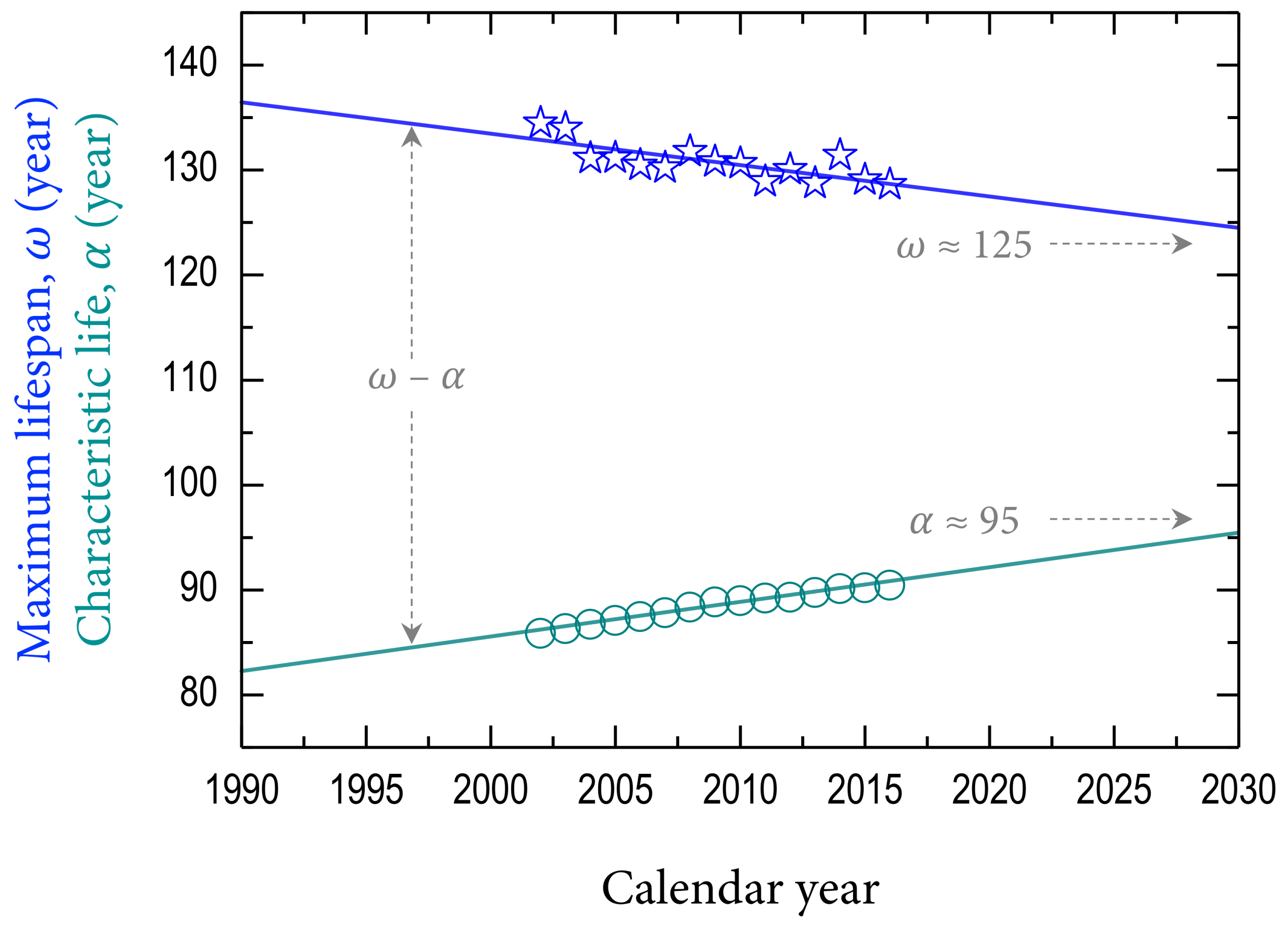Stretched Exponential Survival Analysis for South Korean Females
Abstract
Featured Application
Abstract
1. Introduction
2. Methods
3. Results and Discussion
3.1. Survival Analysis
3.2. Characteristic Life Analysis
3.3. Maximum Lifespan Analysis
3.4. Discussion
4. Conclusions
Funding
Conflicts of Interest
References
- Wilmoth, J.R.; Deegan, L.J.; Lundström, H.; Horiuchi, S. Increase of maximum life-span in Sweden, 1861–1999. Science 2000, 289, 2366–2368. [Google Scholar] [CrossRef] [PubMed]
- Oeppen, J.; Vaupel, J.W. Broken limits to life expectancy. Science 2006, 296, 1029–1031. [Google Scholar] [CrossRef] [PubMed]
- Olshansky, S.J. Ageing: Measuring our narrow strip of life. Nature 2016, 538, 175–176. [Google Scholar] [CrossRef] [PubMed]
- Kontis, V.; Bennett, J.E.; Mathers, C.D.; Li, G.; Foreman, K.; Ezzati, M. Future life expectancy in 35 industrialised countries: Projections with a Bayesian model ensemble. Lancet 2017, 389, 1323–1335. [Google Scholar] [CrossRef]
- Weon, B.M. A solution to debates over the behavior of mortality at old ages. Biogerontology 2015, 16, 375–381. [Google Scholar] [CrossRef] [PubMed]
- Petrascheck, M.; Miller, D.L. Computational analysis of lifespan experiment reproducibility. Front. Genet. 2017, 8, 92. [Google Scholar] [CrossRef] [PubMed]
- Ruby, J.G.; Smith, M.; Buffenstein, R. Naked mole rat mortality rates defy Gompertzian laws by not increasing with age. eLife 2018, 7, e31157. [Google Scholar] [CrossRef] [PubMed]
- Beltrán-Sánchez, H.; Finch, C. Life expectancy: Age is just a number. eLife 2018, 7, e34427. [Google Scholar] [CrossRef] [PubMed]
- Weibull, W.A. A statistical distribution function of wide applicability. J. Appl. Mech. 1951, 18, 293–297. [Google Scholar]
- Kohlrausch, R. Theorie des elektrischen rückstandes in der leidener flasche. Pogg. Ann. Phys. Chem. 1854, 91, 179–214. [Google Scholar] [CrossRef]
- Williams, G.; Watts, D.C. Non-symmetrical dielectric relaxation behavior arising from a simple empirical decay function. Trans. Faraday Soc. 1970, 66, 80–85. [Google Scholar] [CrossRef]
- Weon, B.M.; Je, J.H. Theoretical estimation of maximum human lifespan. Biogerontology 2009, 10, 65–71. [Google Scholar] [CrossRef] [PubMed]
- Weon, B.M.; Je, J.H. Plasticity and rectangularity in survival curves. Sci. Rep. 2011, 1, 104. [Google Scholar] [CrossRef] [PubMed]
- Weon, B.M.; Je, J.H. Trends in scale and shape of survival curves. Sci. Rep. 2012, 2, 504. [Google Scholar] [CrossRef] [PubMed]
- Wrycza, T.; Baudisch, A. The pace of aging: Intrinsic time scales in demography. Demogr. Res. 2014, 30, 1571–1590. [Google Scholar] [CrossRef]
- OECD. Health at a Glance 2017: OECD Indicators; OECD Publishing: Paris, France, 2017. [Google Scholar] [CrossRef]
- Anderson, G.F.; Hussey, P.S. Population aging: A comparison among industrialized countries. Health Aff. 2000, 19, 191–203. [Google Scholar] [CrossRef] [PubMed]
- Robine, J.M.; Michel, J.P. Looking forward to a general theory on population aging. J. Gerontol. A Biol. Sci. Med. Sci. 2004, 59, 590–597. [Google Scholar] [CrossRef]
- Fries, J.F. Aging, natural death, and the compression of morbidity. N. Engl. J. Med. 1980, 303, 130–135. [Google Scholar] [CrossRef]
- Shkrabtak, N.; Frolova, N.; Kiseleva, T.; Sergeeva, I.; Pomozova, V. Impact of environmental conditions on the health of the Far Eastern region population. Appl. Sci. 2019, 9, 1354. [Google Scholar] [CrossRef]
- Hayflick, L. The future of ageing. Nature 2000, 408, 267–269. [Google Scholar] [CrossRef]
- Kim, I.K.; Liang, J.; Rhee, K.O.; Kim, C.S. Population aging in Korea: Changes since the 1960s. J. Cross Cult. Gerontol. 1996, 11, 369–388. [Google Scholar] [CrossRef] [PubMed]
- Bahk, J.; Lynch, J.W.; Khang, Y.H. Forty years of economic growth and plummeting mortality: The mortality experience of the poorly educated in South Korea. J. Epidemiol. Community Health 2017, 71, 282–288. [Google Scholar] [CrossRef] [PubMed]
- Khang, Y.H.; Bahk, J.; Yi, N.; Yun, S.C. Age- and cause-specific contributions to income difference in life expectancy at birth: Findings from nationally representative data on one million South Koreans. Eur. J. Public Health 2016, 26, 242–248. [Google Scholar] [CrossRef] [PubMed]
- Yang, S.; Khang, Y.H.; Harper, S.; Davey Smith, G.; Leon, D.A.; Lynch, J. Understanding the rapid increase in life expectancy in South Korea. Am. J. Public Health 2010, 100, 896–903. [Google Scholar] [CrossRef] [PubMed]
- NCD-RisC. A century of trends in adult human height. eLife 2016, 5, e13410. [Google Scholar] [CrossRef] [PubMed]
- NCD-RisC. Trends in adult body-mass index in 200 countries from 1975 to 2014: A pooled analysis of 1698 population-based measurement studies with 19.2 million participants. Lancet 2016, 387, 1377–1396. [Google Scholar] [CrossRef]
- NCD-RisC. Worldwide trends in blood pressure from 1975 to 2015: A pooled analysis of 1479 population-based measurement studies with 19.1 million participants. Lancet 2017, 389, 37–55. [Google Scholar] [CrossRef]
- Di Cesare, M.; Khang, Y.H.; Asaria, P.; Blakely, T.; Cowan, M.J.; Farzadfar, F.; Guerrero, R.; Ikeda, N.; Kyobutungi, C.; Msyamboza, K.P.; et al. Inequalities in non-communicable diseases and effective responses. Lancet 2013, 381, 585–597. [Google Scholar] [CrossRef]
- OECD. Health at a Glance 2015: OECD Indicators; OECD Publishing: Paris, France, 2015. [Google Scholar] [CrossRef]
- Lim, D.; Ha, M.; Song, I. Trends in the leading causes of death in Korea, 1983–2012. J. Korean Med. Sci. 2014, 29, 1597–1603. [Google Scholar] [CrossRef]
- Choe, Y.J.; Choe, S.A.; Cho, S.I. Trends in infectious disease mortality, South Korea, 1983–2015. Emerg. Infect. Dis. 2018, 24, 320–327. [Google Scholar] [CrossRef]
- Carnes, B.A.; Witten, T.M. How long must humans live? J. Gerontol. A Biol. Sci. Med. Sci. 2014, 69, 965–970. [Google Scholar] [CrossRef]
- Dong, X.; Milholland, B.; Vijg, J. Evidence for a limit to human lifespan. Nature 2016, 538, 257–259. [Google Scholar] [CrossRef] [PubMed]
- Newman, S.; Easteal, S. The dynamic upper limit of human lifespan [version 1; referees: 1 approved, 1 approved with reservations]. F1000Research 2017, 6, 569. [Google Scholar] [CrossRef] [PubMed]
- Marck, A.; Antero, J.; Berthelot, G.; Saulière, G.; Jancovici, J.M.; Masson-Delmotte, V.; Boeuf, G.; Spedding, M.; Le Bourg, E.; Toussaint, J.F. Are we reaching the limits of homo sapiens? Front. Physiol. 2017, 8, 812. [Google Scholar] [CrossRef] [PubMed]
- Carnes, B.A.; Olshansky, S.J. Heterogeneity and its biodemographic implications for longevity and mortality. Exp. Gerontol. 2001, 36, 419–430. [Google Scholar] [CrossRef]
- Vaupel, J.W. Biodemography of human ageing. Nature 2010, 464, 536–542. [Google Scholar] [CrossRef]
- Ben-Haim, M.S.; Kanfi, Y.; Mitchel, S.J.; Maoz, N.; Vaughan, K.; Amariglio, N.; Lerrer, B.; de Cabo, R.; Rechavi, G.; Cohen, H.Y. Breaking the ceiling of human maximal lifespan. J. Gerontol. A Biol. Sci. Med. Sci. 2018, 73, 1465–1471. [Google Scholar] [CrossRef]
- Brown, N.J.L.; Albers, C.J.; Ritchie, S.J. Contesting the evidence for limited human lifespan. Nature 2017, 546, E6–E7. [Google Scholar] [CrossRef][Green Version]
- De Beer, J.; Bardoutsos, A.; Janssen, F. Maximum human lifespan may increase to 125 years. Nature 2017, 546, E16–E17. [Google Scholar] [CrossRef]
- Hughes, B.G.; Hekimi, S. Many possible maximum lifespan trajectories. Nature 2017, 546, E8–E9. [Google Scholar] [CrossRef]
- Lenart, A.; Vaupel, J.W. Questionable evidence for a limit to human lifespan. Nature 2017, 546, E13–E14. [Google Scholar] [CrossRef] [PubMed]
- Rozing, M.P.; Kirkwood, T.B.L.; Westendorp, R.G.J. Is there evidence for a limit to human lifespan? Nature 2017, 546, E11–E12. [Google Scholar] [CrossRef] [PubMed]
- Rootzen, H.; Zholud, D. Human life is unlimited–but short. Extremes 2017, 20, 713–728. [Google Scholar] [CrossRef]
- De Magalhães, J.P.; Stevens, M.; Thornton, D. The business of anti-aging science. Trends Biotechnol. 2017, 35, 1062–1073. [Google Scholar] [CrossRef] [PubMed]




© 2019 by the author. Licensee MDPI, Basel, Switzerland. This article is an open access article distributed under the terms and conditions of the Creative Commons Attribution (CC BY) license (http://creativecommons.org/licenses/by/4.0/).
Share and Cite
Weon, B.M. Stretched Exponential Survival Analysis for South Korean Females. Appl. Sci. 2019, 9, 4230. https://doi.org/10.3390/app9204230
Weon BM. Stretched Exponential Survival Analysis for South Korean Females. Applied Sciences. 2019; 9(20):4230. https://doi.org/10.3390/app9204230
Chicago/Turabian StyleWeon, Byung Mook. 2019. "Stretched Exponential Survival Analysis for South Korean Females" Applied Sciences 9, no. 20: 4230. https://doi.org/10.3390/app9204230
APA StyleWeon, B. M. (2019). Stretched Exponential Survival Analysis for South Korean Females. Applied Sciences, 9(20), 4230. https://doi.org/10.3390/app9204230




